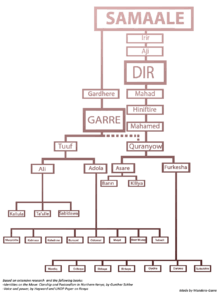Garre
The Garre are a Somali pastoralist clan genealogically belonging to the Gardheere Samaale, with the Quranyow section of the Garre originally belonging to the Dir clan family. They live in southern Somalia, northeastern Kenya and southern Ethiopia.
Almost all Garre people speak the Garre language, which is an East Omo-Tana that is taxonomically a distinct language (closely related to the Aweer language) but sociologically perceived as a dialect of Somali by both the Garre themselves and neighboring clans whom speak Somali[1]. Garre clans use three languages to communicate among themselves, including the common Somali; the Rahanwein dialect of Southern Somalia, and the ‘Garre’ language of Mandera, which is a Somalised dialect of Borana. [2]Their urban centers include Mandera, El Wak, Moyale, Takaba, Banissa, Wargadud, Rhamu and Kutulo. A substantial number of Garre people are also found in major cities of Kenya such as Nairobi, Mombasa and Kisumu.
Distribution
In Southern Somalia, they live in Kofur near Mogadishu and Lower Shabelle Afgooye, Waanlaweyn, Qoronyoley, Merca, and Awdhagle Districts, and El Wak District in Gedo, Jubaland. In Ethiopia, they live in Moyale, Hudet, Mubarak, Qadaduma, Suruba, Raaro, Lehey and Woreda of Dawa zone. In Kenya, the Garre inhabit Mandera County, Wajir, North Moyale, as well as part of Isiolo County.
The largest population and composition of Garres live in Mandera County, making them the single largest clan in Mandera County.[3] They are largely in Kenya and Ethiopia. The Garre claim descent from Samaale[4] although they fall under the Rahanweyn politically in the borders of Somalia as sub-clan of the Digil clan due to isolation from other Garre's, but because Garre are camel keeping nomands and not farmers they do not claim descend from them[5]
Garre clan structure
The Garre are divided into the Tuff and Quranyow sub-clans. While the Tuffs are further divided into the Ali and Adola groups, the Quranyow are divided into the Asare and Furkesha.[6]The Quranyow section of the Garre claim descent from mahe Dir, who are born of the Irir Samaale while the Tuffs descent from Gardhere Samaale[7]
In history, Identities on the Move: Clanship and Pastoralism in Northern Kenya, by Gunther Schlee, Voice and Power, by Hayward and UNDP Paper on Kenya, the Garre are divided into the following clans.[8][6][7]

- Samaale
- Gardheere
- Garre
- Tuuf
- Ali
- Adola
- Quranyow (claim descent from Dir)
- Furkesha
- Asare
- Tuuf
In the book Identities on the Move: Clanship and Pastoralism in Northern Kenya, by Gunther Schlee, Voice and power, by Hayward and UNDP Paper on Kenya, they stress that the Kuranyo (Quranyow) section of the Garre are of Dir descent.[8][6][7]
References
- Mauro Tosco. 2012. The Unity and Diversity of Somali Dialectal Variants. In Nathan Oyori Ogechi and Jane A. Ngala Oduor and Peter Iribemwangi (eds.), The Harmonization and Standardization of Kenyan Languages. Orthography and other aspects, 263-280. Cape Town: The Centre for Advanced Studies of African Society (CASAS).
- "Dynamics and Trends of Conflict in Greater Mandera" (PDF).
- UNDP paper
- Ahmed, Ali Jimale (1995-01-01). The Invention of Somalia. The Red Sea Press. p. 131. ISBN 9780932415998.
- Worldbank, Conflict in Somalia: Drivers and Dynamics, January 2005, Appendix 2, Lineage Charts, p.55 Figure A-1
- Hayward, R. J.; Lewis, I. M. (2005-08-17). Voice and Power. Routledge. p. 242. ISBN 9781135751753.
- UNDP paper (Kenya)
- Schlee, Günther (1989-01-01). Identities on the Move: Clanship and Pastoralism in Northern Kenya. Manchester University Press. p. 25. ISBN 9780719030109.